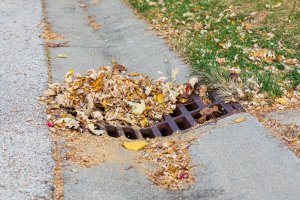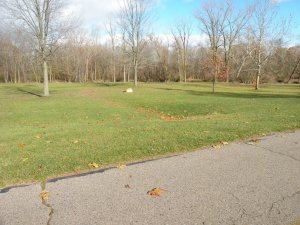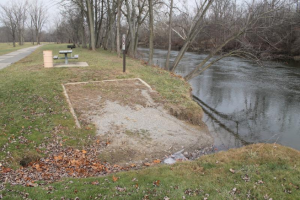Green Infrastructure Supports Wildlife and Water Quality Goals
April 26, 2023
Erin Parker, Interpretive Services Supervisor
As your Metroparks consider the future of the parks, one logical plan is to replacing aging infrastructure with environmentally friendly landscaping. Green infrastructure uses plants to filter, absorb, retain, and otherwise slow the flow of stormwater and all the bacteria, viruses, chemicals, debris, and other pollutants that it carries. Contrast green infrastructure with the traditional gray infrastructure- all the pipes, sewers, culverts, and other hard surfaces once designed to rapidly move water away from buildings and roads. As this infrastructure has aged and as urbanized, hard, non-porous surfaces have increased throughout the region, the need to capture precipitation before it becomes stormwater and has become more important.

Green infrastructure projects can be found throughout the Metroparks as we consider local and regional concerns about keeping our waterways clean and useable for people and wildlife. Replacing aging gray infrastructure with plants, swales, and other ways of managing water builds climate resiliency into our parks, increases wildlife habitat, and adds to the connected green spaces that wildlife utilize to move around our parks and communities.
Protecting the Lake Erie Marsh and Waters
One of our newer Metroparks projects works to protect the important coastal marsh and waters of Lake Erie Metropark. This project has several components. The first is the development and installation of sixteen bioswales along park roads and parking lots. Bioswales are long trenches or depressions that carry water off hard surfaces such as parking lots and rooftops. Unlike the traditional gray infrastructure like culverts or storm drains, swales are planted with native plants.

These plants serve multiple purposes – slowing the flow of the water, filter out pollutants, and even give water warmed by dark parking lot surfaces time to cool before entering the lake. These plants are selected to provide pollinator and songbird habitat throughout the year with flowers, seeds, and even stems providing food and shelter.
Along with the bioswales, two new rain gardens will be constructed near the Marsh Museum. Like bioswales, raingardens are deliberately built and planted depressions to capture rain water and snow melt. Rain gardens provide opportunity for demonstrating techniques for homeowners and community members to make positive changes to their own yards and green spaces. They can add interest to the landscape with colorful flowers and attract beneficial pollinating insects. Interested visitors can even become certified Master Rain Gardeners and install their own rain gardens: https://therouge.org/master-rain-gardener/
Additionally, in partnership with the Wyandot of Anderdon Nation, HCMA will be restoring 8 acres of wetland habitat just north of Lake Erie Metropark at a site called Wyandot Six Points. This site is approximately 15 acres in total and is on ancestral ground of the Wyandot. Restoring this wetland includes removal of a variety of non-indigenous plants and replacing them with wetland plants native to the region.
In total, this project is anticipated to capture 1.67 million gallons of stormwater each year before it enters Lake Erie and is expected to be completed by April 2025.
Willow Metropark Big Bend Restoration
While the Lake Erie and Six Points project just kicked off in May of 2022, another improvement project is in its final stages. The restoration of the Big Bend area of Willow Metropark worked with the Huron River Watershed Council to improve habitat, restore eroded areas of the Huron River’s band, create and install habitat features, and improve habitat connectivity between the forested floodplain and native prairies. Along with reducing stormwater impacts to the river, this project focuses a lot on increasing wildlife diversity.

Improving this piece of the park involved removing an unused parking lot, creating bioswales, and increasing the size of a nearby prairie and restoring the plant community there. There were also changes made to reduce the impacts of the flow of the water through the large bend that exists in the Huron River here. Through time, water moving through the bend erodes the bank, reducing the area for picnicking, fishing and other recreation. As sediments are released through erosion, things like phosphorous (commonly found in fertilizers and organic matter) are added to the water. Phosphorous and other fertilizers can cause nutrient-loading that feeds algae and other aquatic plants, further reducing water quality and flow.
Slowing the movement of the river at this point also allowed for additional in-stream habitat for fish to be installed. Trees that fell throughout the park were collected and added to the bank bottom at Big Bend to redirect the water’s energy towards the center of the river and away from the edges. This provides cover for fish and other aquatic animals, as well.
This spring, native plants will be added to the bioswales to continue improving water quality and habitat diversity. Funding for this project came from the National Fish and Wildlife Foundation through a Southeast Michigan Resilience Fund Grant.
Look for examples of green infrastructure throughout the parks as we plan for the diverse needs of visitors and wildlife now and into the future.
Resources:
